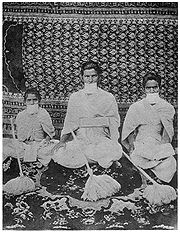
Sthanakvasi
Encyclopedia
Sthānakavāsī is a sect of Jainism
founded by a merchant named Lavaji about 1653 CE that believes that God is nirakar "without form", and hence do not pray to any statue. The sect is essentially a reformation of the one founded on teachings of Lonka, a fifteenth-century Jainist reformer.
Their place of worship is sthanaka, which is only a temporary abode of visitors, both saints and followers. It is considered a sin to touch an adult person of another gender during the prayers offered at the sthanaka.
Sthānakavāsīs reject all but thirty-two of the Śvētāmbara
canon, which leads to natural comparisons with the Terapanthi movement.
There are about half a million Sthānakavāsī Jains in North India
, and Śvētāmbarins who are not Sthānakavāsins are called Murtipujaka
.
 Saints (ascetic Sthanakvasins, called yatis) wear white clothes and cover their mouths with a square white cloth or muhapatti
Saints (ascetic Sthanakvasins, called yatis) wear white clothes and cover their mouths with a square white cloth or muhapatti
intended to minimize the risk of inhaling small insects or other airborne life forms, which Sthanakvasins see as a violation of ahimsa
"non-violence". They eat food collected from followers' houses and do not save edibles beyond the next meal and water is not kept even for a single night. All eating and drinking has to be done between sunrise and sunset.
Saints do not stay at one place for too long except for the four monsoon months, the chaturmas
. Saints are also called dhundhiya "searchers" for their early practice of searching out and staying in abandoned or neglected structures to avoid disturbance from the public. Saints own no possessions except for a few books, a couple sets of clothes and carrying utensils made of a special natural material.
Jainism
Jainism is an Indian religion that prescribes a path of non-violence towards all living beings. Its philosophy and practice emphasize the necessity of self-effort to move the soul towards divine consciousness and liberation. Any soul that has conquered its own inner enemies and achieved the state...
founded by a merchant named Lavaji about 1653 CE that believes that God is nirakar "without form", and hence do not pray to any statue. The sect is essentially a reformation of the one founded on teachings of Lonka, a fifteenth-century Jainist reformer.
Their place of worship is sthanaka, which is only a temporary abode of visitors, both saints and followers. It is considered a sin to touch an adult person of another gender during the prayers offered at the sthanaka.
Sthānakavāsīs reject all but thirty-two of the Śvētāmbara
Svetambara
The Śvētāmbara is one of the two main sects of Jainism, the other being the Digambar. Śvētāmbara "white-clad" is a term describing its ascetics' practice of wearing white clothes, which sets it apart from the Digambara "sky-clad" Jainas, whose ascetic practitioners go naked...
canon, which leads to natural comparisons with the Terapanthi movement.
There are about half a million Sthānakavāsī Jains in North India
North India
North India, known natively as Uttar Bhārat or Shumālī Hindustān , is a loosely defined region in the northern part of India. The exact meaning of the term varies by usage...
, and Śvētāmbarins who are not Sthānakavāsins are called Murtipujaka
Murtipujaka
Murtipujaka, also known as Deravasi, is the term for a sect of Jainism that includes most Svetambaras.Murtipujaka Svetambaras differ from Sthanakvasi Svetambaras in that their derasars contain idols of the Tirthankaras instead of empty rooms....
.
Saints

Muhapatti
The muhapatti is a square of white cloth worn across the face and tied behind the ears or held. The purpose is to prevent saliva from coming into contact with sacred books, images or other items. It is often purported to be worn to reduce the chance of inhaling small insects and other airborne...
intended to minimize the risk of inhaling small insects or other airborne life forms, which Sthanakvasins see as a violation of ahimsa
Ahimsa
Ahimsa is a term meaning to do no harm . The word is derived from the Sanskrit root hims – to strike; himsa is injury or harm, a-himsa is the opposite of this, i.e. non harming or nonviolence. It is an important tenet of the Indian religions...
"non-violence". They eat food collected from followers' houses and do not save edibles beyond the next meal and water is not kept even for a single night. All eating and drinking has to be done between sunrise and sunset.
Saints do not stay at one place for too long except for the four monsoon months, the chaturmas
Chaturmas
Chaturmas is a holy period of four months , beginning on Shayani Ekadashi—the eleventh day of the first bright half, Shukla paksha, of Ashadh —until Prabodhini Ekadashi, the eleventh day of the first bright half of Kartik in Hinduism, Buddhism and Jainism.Chaturmas is reserved the...
. Saints are also called dhundhiya "searchers" for their early practice of searching out and staying in abandoned or neglected structures to avoid disturbance from the public. Saints own no possessions except for a few books, a couple sets of clothes and carrying utensils made of a special natural material.

